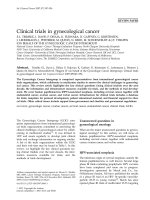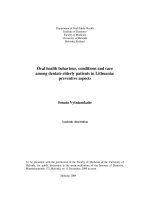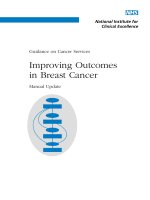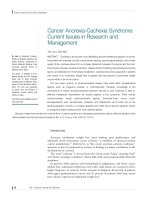FERTILITY ISSUES IN CHILDHOOD CANCER TREATMENT pptx
Bạn đang xem bản rút gọn của tài liệu. Xem và tải ngay bản đầy đủ của tài liệu tại đây (473.27 KB, 16 trang )
Fertility Issues in Childhood
Cancer Treatment
Information and Resources for our Families in the
LPCH Pediatric Oncology Department
©Lucile Salter Packard Children’s Hospital, 725 Welch Rd. Palo Alto, CA 94304
I. Introduction
II. What are possible effects of cancer therapies on my child’s reproductive system?
III. Questions to ask your doctor before therapy
IV. Factors that affect the risk of infertility
a. Common cancers in childhood and adolescence
b. Chemotherapy
c. Radiotherapy
d. Information for hematology patients receiving bone marrow transplants
V. Before therapy: Options for protecting fertility
VI. After therapy: Important health and social issues
VII. Additional resources
VIII. Important contact information
Page 2
Introduction After your child has been diagnosed with cancer, survival is your first concern.
While medical advances have helped most children survive cancer, treatments for cancer may
cause side effects. Infertility, or the inability to have children, is a side effect of some cancer
therapies. Even though your child’s future fertility may not be a main concern at the time of
diagnosis, there are ways to help protect their chances to have children in the future. It is
important to check into these options before starting treatment. It is also important to be
aware of the effects of cancer treatment on future child-bearing to know what to expect after
completion of therapy.
The goal of this booklet is to offer the most up-to-date information on both the
infertility risk (based on your child’s disease and treatment) as well as options to save fertility
that are available at Lucile Salter Packard Children’s Hospital and in the nearby area. We
hope that the information in this booklet will help you to understand your child’s risks and
options, so that you can make a decision that is best for your family. Please be sure to talk
with your child’s health care provider about any questions or concerns.
Acknowledgements:
FertileHope
Stanford School of Medicine Medical Scholars Program
Patients and Staff of Clinic E (Lucile Salter Packard Children’s Hospital)
Michaela Kiernan, PhD, Stanford Prevention Research Center
Dr. Melissa Hudson, St. Jude Children’s Research Hospital, Memphis, TN
Dr. Lynn Westphal, Stanford Obstetrics/Gynecology, Female Infertility Specialist
Dr. Stewart McCallum, Stanford Urologist, Male Infertility Specialist
Dr. Gary Dahl, LPCH Pediatric Oncologist
Page 3
What are possible effects of cancer treatment on the reproductive system?
Cancer therapies can affect hormone production and the ability to have children in different
ways. The following is a list of possible effects on fertility caused by cancer treatment:
Delayed or Early Puberty: During puberty a girl or boy starts to develop adult physical
changes. For a girl this usually happens between the ages of 8 and 13 years and for a boy this
usually happens between the ages of 10 to 15 years. The first signs of puberty are usually the
growth of breast buds in females and testicular enlargement in males. However, hair under the
arms and in the pubic areas may be the first thing that you will notice because it is usually a
more noticeable change. Children who have been treated for cancer can have a delayed or an
early (precocious) start to puberty. Children who have to take hormone therapy to go through
puberty are at risk for infertility. An endocrinologist, a specialist who treats problems with
glands that make hormones, can do tests to find out if hormone therapy is needed to help
puberty go on at a normal rate and time.
Infertility (females): For females, infertility occurs when there is damage to the eggs, uterus,
fallopian tubes, or ovaries. Women are born with all of the eggs that they will have for their
lifetime. Cancer treatment can damage some or all of these eggs. Because women are born
with all of their eggs, they cannot be replaced. This is the main cause of infertility in young
women who have been treated for cancer.
Infertility (males): For males, infertility usually occurs because the sperm are low in number
or are no longer being made due to effects of the cancer treatment on the testicles. Infertility
in males can also be caused by damage to the cells in the testes that make the male hormone,
testosterone (see below for more details about Leydig cell dysfunction). Men who have
already gone through puberty can check their fertility after cancer treatment by giving a
semen sample at the California Cryobank (see the contacts section).
Leydig Cell Dysfunction (males): Chemotherapy and radiation that injure the Leydig cells
can result in low levels of testosterone. Low testosterone levels may reduce sex drive and
result in problems with sexual functioning. Testosterone is also an important hormone for
bone health. Men with low testosterone levels may have thinner, weaker bones
(osteoporosis). Hormone therapy may be needed in men who have low testosterone levels. If
blood tests show a low testosterone level after cancer treatment, your doctor may also order a
bone density test to check bone strength. If bone strength is lower than normal, getting
enough calcium and vitamin D (in the diet or by taking a supplement), exercising regularly,
and not smoking can help keep bones strong and healthy in men with low levels of
testosterone. The treatments that are more likely to cause Leydig cell dysfunction are shown
in the table on page 8.
Premature ovarian failure: Normally women go through menopause (natural ovarian failure
that occurs with aging) after 40 years of age. The average age is 51 years old. However, some
female patients go through premature ovarian failure, or early menopause, during or after
cancer treatment. In one large study at 5 pediatric cancer centers, the average age for
menopause was 31 years old for young women treated for cancer with certain chemotherapies
and radiation to the abdomen. In women who have had cancer treatment, early menopause is
a sign of infertility. It is important for a young woman who wants to have children in the
Page 4
future to plan child-bearing based on her risk of early menopause. This could include storing
eggs to use later. Some signs of early menopause include hot flashes, mood swings, night
sweats, and irregular periods with little or no bleeding. In early menopause, the levels of
hormones made by the ovaries are low. Women who go through early menopause should
discuss the risks and benefits of taking hormone therapy with their doctor. Low levels of
ovarian hormones also increase the risk of bone thinning (osteoporosis). Getting enough
calcium and vitamin D (in the diet or by taking a supplement), exercising regularly, and not
smoking can help keep bones strong and healthy in women who go through early menopause.
Questions to ask your doctor before therapy
Even though your child may be many years away from having children of his or her own,
thinking about his or her fertility before starting cancer treatment can help increase the
chances of being able to have children in the future. Talk to your medical team about how
your child’s therapy will affect fertility. Below are some possible questions to ask your
doctor:
• Will treatment have any short or long term side effects on my child’s reproductive
system?
o Will the treatments affect hormone levels that control puberty and the ability to
have children?
o Is there any chance of having puberty start earlier or later than kids who do not
have cancer treatment?
o Is infertility a possible side effect of treatment?
• Are there other ways to treat the cancer that will cause less damage to the reproductive
system?
• Are there ways to save (preserve) fertility before, during and after cancer treatment?
• Do treatments that preserve fertility work as well against the cancer as those that cause
infertility?
• After treatment, how will I know if I will be able to have children?
• How can a girl find out if she is at risk to enter menopause early?
Page 5
Factors that affect the risk of infertility
The risk of infertility varies for different types of cancers and cancer treatments. The tables
below give an estimate of the possible risk of infertility based on studies of childhood cancer
survivors who are now adults. The risk of infertility after specific childhood cancers and
cancer treatments may be high, medium, or low to none. Based on the risk, you can decide
whether or not you would like to look into ways to preserve your child’s fertility before
starting cancer treatment.
Infertility risk based on common cancers of childhood and adolescence
High risk:
Any cancer or hematologic illness treated with bone marrow transplantation
Hodgkin’s disease treated with 6 or more months of alkylating drugs
Soft-tissue and Ewing’s sarcoma that has spread to distant organs (metastatic)
Medium risk:
Acute myeloid leukemia
Hepatoblastoma
Osteosarcoma
Ewing’s sarcoma that has not spread to distant organs or tissues
Soft-tissue sarcoma that has not spread to distant organs or tissues
Neuroblastoma
Non-Hodgkin lymphoma
Hodgkin’s disease treated with 3 or less months of alkylating drugs
Brain tumor treated with radiation to brain and/or spine
Low to no risk:
Acute lymphoblastic leukemia
Wilms’ tumor
Germ-cell tumors that are not treated with radiation
Retinoblastoma
Brain tumor treated with surgery only or low dose radiation to brain
Page 6
Infertility risk based on chemotherapy treatment
High Risk:
Chemotherapy conditioning for bone-marrow transplantation
Cyclophosphamide above 4,000 mg/m
2
for males
Cyclophosphamide above 15,000 mg/m
2
for females
Ifosfamide
Mechlorethamine
Busulfan
Melphalan
Procarbazine
Chlorambucil
Specific Regimens: MOPP, COPP/ABV
Medium Risk:
Cyclophosphamide below 4,000 mg/m
2
for males
Cyclophosphamide below 15,000 mg/m
2
for females
Cisplatin
Carboplatin
Doxorubicin
Specific Regimens: VAMP w/COP
Low Risk/No Risk:
Cytarabine
Vincristine
Methotrexate
Dactinomycin
Bleomycin
Mercaptopurine
Vinblastine
Page 7
Risk of infertility based on radiation treatment
High Risk Males:
Pelvic radiation
Testicular radiation
Cranial radiation with high or medium risk chemotherapy
High Risk Females:
Ovarian or pelvic radiation
Cranial radiation with high or medium risk chemotherapy
Risk of Leydig cell dysfunction (low testosterone) based on radiation
Pelvic or testicular radiation
Medium or high risk chemotherapy in boys who have gone through puberty (see page 3 for
more information on Leydig cell dysfunction)
All risk table information has been estimated based on discussions with practicing physicians and the following
article: Wallace WH, Anderson RA, Irvine DS. Fertility preservation for young patients with cancer: who is at
risk and what can be offered? Lancet Oncol 2005;6(4):209-18. Please discuss the risk levels with your doctor.
Page 8
Before therapy: Options for protecting fertility
Families and patients often ask what can be done before treatment begins to protect future
fertility. Your doctor can tell you if the risk of infertility is low based on the cancer
treatments planned. In these cases, special procedures to protect fertility are not needed. If
the risk of infertility is medium or high, you may want to check into options that will help
preserve fertility. The different options will depend on whether the patient has or has not
gone through puberty. The chart below describes potential options for each age group and sex,
followed by definitions and explanations of these terms.
Girls Boys
Ovarian shielding
Ovarian transposition
Testicular shielding
Before puberty
Experimental options:
Hormone therapy
Ovarian tissue cryopreservation
Experimental option:
Testicular Tissue Freezing (TTF)
Ovarian shielding
Ovarian transposition
Embryo Cryopreservation
Sperm banking
Testicular shielding
Embryo cryopreservation
After puberty
Experimental options:
Hormone therapy
Oocyte cryopreservation
Ovarian tissue cryopreservation
Definitions from table:
Oocyte Cryopreservation: For girls who have already gone through puberty, oocyte
cryopreservation (egg freezing) is a good option. While this is still a new, experimental
procedure, it has resulted in successful pregnancies. The procedure involves stimulating the
ovaries with fertility medications that are given by injection into a muscle for two weeks.
During this time, the patient’s ovaries are monitored by ultrasound every 1 to 3 days. When
the eggs have developed to the right stage, they are removed during a short outpatient
procedure by inserting a needle into the ovaries. The eggs can be stored until the woman is
ready to become pregnant. At this time, the eggs are fertilized with sperm from a partner or
donor and the embryo that develops is then inserted into the uterus. To date, about 200
Page 9
pregnancies have been achieved with this technique. If your family is interested in this option,
please make an appointment with Dr. Lynn Westphal (see contacts section).
Embryo Cryopreservation: Embryo cryopreservation (embryo freezing) is a proven, safe
option for preserving fertility. Eggs are harvested from the ovaries in a process similar to that
described above in the egg freezing procedure. Like the egg freezing procedure, this
procedure often involves stimulating the ovaries with fertility medications that are given by
injection into a muscle for two weeks. During this time, the patient’s ovaries are monitored
by ultrasound every 1 to 3 days. The eggs are then fertilized with sperm from a partner or
donor and the embryo that develops is frozen. The embryo is frozen until the woman is ready
to start a family. The fertilized egg is placed into the uterus through an IVF (in-vitro
fertilization) procedure. This procedure is a very safe, ultrasound guided procedure that helps
infertile couples to conceive every day. It is important to keep the timing in mind when
deciding on this treatment option. The first pregnancy from a frozen embryo was in 1983, and
since then thousands of children have been born following embryo freezing. Today, most
centers show about a 20-30% success rate of term pregnancy per embryo stored. Often times
many embryos are stored to increase the chance of pregnancy. If you are interested in this
option your family should contact Dr. Lynn Westphal (see contacts section).
Hormone therapy: Some studies have shown that giving a hormone called GnRH to girls, or
the hormones in birth control pills to women, may reduce the risk of damage to the ovaries
caused by cancer treatments. Other studies have not shown a benefit in preserving ovarian
function in women who received these treatments. Because not all patients have been helped
by these treatments, using medicines like GnRH and birth control pills to save fertility is
controversial. You should discuss the risks and benefits of these treatments with your
oncologist, gynecologist, or endocrinologist.
Ovarian Tissue Cryopreservation: This is an experimental procedure that involves the
surgical removal of a piece of ovarian tissue. To date, only 1 to 2 pregnancies have been
reported after using this technique. This procedure is an option for girls who have not gone
through puberty or for girls who can not wait the 2 weeks to start treatment that is required for
egg or embryo freezing. The piece of ovarian tissue is frozen until after treatment when the
patient is ready to have children. In successful trials, the ovarian tissue has been put back into
the pelvis by a brief, simple outpatient surgery. When the ovarian tissue is put back into the
body, the hope is that it will begin to function like normal ovarian tissue. If the transplanted
ovarian tissue produces hormones normally, this procedure can reduce the risk of early
menopause and infertility.
Ovarian Transposition: This is a method used to reduce damage to the ovaries during pelvic
radiation for Hodgkin’s disease and other cancers that require radiation in the pelvis. Surgery
is done to move the ovaries to another area of the body to help protect them from the radiation
treatment. After therapy is complete, the ovaries can be moved back to their original location.
After treatment for some cancers, the ovaries remain in the new location and can still function
normally. If pelvic radiation is part of your child’s treatment, please talk to your oncologist
about this option. It is also possible to perform ovarian tissue harvesting at the same time as
this procedure. Please contact Dr. Lynn Westphal (see contacts section) if you are interested
in learning more about this procedure.
Page 10
Ovarian/Testicular Shielding: Radiation shielding is routinely done in children treated with
abdominal or pelvic radiation, unless the shielding will increase the chances of cancer relapse.
For boys, the doctor will place lead-lined shields over one or both testicles. For girls, shields
are placed over one or both ovaries. This may help reduce the risk of damage to the testicles
or ovaries during treatment. These methods are only used for radiation and not for
chemotherapy. This is something that your radiation oncologist will be able to talk to you
more about.
Sperm Banking: This is a simple way for boys who have gone through puberty to preserve
fertility before treatment. This is recommended for all male patients who are at high or
medium risk for infertility. Semen samples can be collected as frequently as every day before
starting cancer treatment and stored for future use. This is a worthwhile option even if only
one deposit can be given, or even if the sperm count is low. The sample can remain frozen
indefinitely. There is a sperm bank located across the street from LPCH called California
Cryobank (see contacts section).
Testicular Tissue Freezing (TTF): This is an option for boys who have not gone through
puberty and cannot provide a sperm sample. The procedure involves an outpatient surgery to
remove a small amount of tissue from the testicles and freeze it for future use. There have
been no live births reported in boys who have undergone testicular tissue freezing, so the
procedure is still considered experimental. Dr. Stewart McCallum (see contacts section) can
perform this surgery at Stanford Hospital. For more information about this procedure please
ask your oncologist and/or set up an appointment directly with Dr. McCallum
Page 11
After therapy: Important health and social issues
Once cancer therapy is completed and remission is achieved, staying healthy is important to
assure that survivors live a long time and with a good quality of life. Regular check-ups by
your oncology team and a primary care physician are important to check for late effects of
cancer treatment. All of your health care providers should know about your child’s past
cancer treatment so they can monitor for treatment side effects.
The list below shows topics to review with your doctor after therapy:
Girls Boys
Before puberty
• Check growth and puberty
• Check growth and puberty
After puberty
• Check growth and puberty
• Menstrual history
• Measure hormone levels
(FSH, LH, estrogen)
• Check growth and puberty
• Semen analysis (sperm count
and motility)
• Measure hormone levels
(testosterone, DHT)
Other important considerations after treatment:
Sexually-transmitted diseases and unplanned pregnancies: Whether or not cancer treatment is
given that may affect fertility, it is important to advise childhood cancer survivors about the
risk of sexually-transmitted diseases and unplanned pregnancies. Practicing safe sex is
important for everyone to reduce the risk of sexually-transmitted diseases. Some studies have
shown that cancer survivors may think they are not able to have children and then have an
unplanned pregnancy. Childhood cancer survivors should be counseled about measures to
take to avoid sexually-transmitted diseases and unplanned pregnancies.
Pregnancy and parenthood after cancer: Studies so far have shown that most children born to
cancer survivors have no greater risk for birth and genetic defects than children born to
individuals who have not had cancer. Most children of cancer survivors also do not have
higher rates of getting cancer themselves. However, some rare forms of cancer are hereditary
or can "run in families". These may occur in individuals who have cancer in both sides of
paired organs (for example eyes, ears, breasts, kidneys, etc.) or who have many family
members with cancer (the same or different types). If you are not sure whether or not your
child’s cancer type is a hereditary type, ask your oncologist. Female cancer survivors who
Page 12
have had cancer treatments that can affect heart function, or radiation to the abdomen and
pelvis should be aware that they may have a higher risk of complications during pregnancy,
labor or delivery. Women who have had these cancer treatments should consult with their
doctor before becoming pregnant. Please keep in mind that there are many ways to become a
parent, including adoption, surrogacy, and donor eggs and sperm.
Sperm Extraction: Some men who find out after treatment that they do not have sperm in the
ejaculate, will still have sperm available in the testes or stored in a nearby collecting structure
called the epididymis. These men can have the sperm aspirated or extracted in a minor out-
patient procedure. The extracted sperm can then be frozen for later use.
Page 13
Additional resources
If you would like to learn more information about fertility issues and cancer, the following
websites offer extensive information:
Fertility Issues:
1. FertileHope: Through programs of awareness, education, financial assistance, research and
support, Fertile Hope is providing cancer survivors with the tools they need to fulfill their
parenthood dreams. Online resources include message boards, informational packets, and
news updates on research advances and advocacy efforts. For more information, please call
(888) 994-HOPE or visit
www.fertilehope.org.
2. Lance Armstrong Foundation:
www.livestrong.org
Late Effects of Cancer Treatment Health Information:
1. Children's Oncology Group (COG) Survivorship Guidelines
Male: www.survivorshipguidelines.org/pdf/MaleHealthIssues.pdf
Female: www.survivorshipguidelines.org/pdf/FemaleHealthIssues.pdf
Other late effects topics: www.survivorshipguidelines.org
2. Premature Ovarian Failure Support Group: www.pofsupport.org/
Page 14
Important contact information
Female infertility specialist (ovarian tissue and egg freezing), Stanford Hospital:
Lynn Westphal, M.D., Lisa Murray, R.N. (650) 498-7272
Male infertility specialist (testicular tissue freezing), Stanford Hospital:
Stewart McCallum, M.D. (650) 723-5546
Pediatric Endocrinology, LPCH (hormone issues, early/delayed puberty):
Laura Bachrach, M.D., Patricia Fechner, M.D, and Kirk Neely, M.D.
Please fax referral form to: 650-725-8379
California Cryobank
Location: Stanford Barn 700 Welch Road, Suite 107
(650)-324-1900
For almost 30 years California Cryobank has been the leader in reproductive tissue services.
California Cryobank has a dedicated staff to help patients with their storage needs and we
strongly believe in helping every
patient preserve their fertility. No patient will be turned
away. California Cryobank has a tradition of assisting patients financially and helps each
patient on a case by case basis. For that same reason, patients from Packard Hospital receive
an immediate 15% discount off our storage services. In addition, California Cryobank
participates in the Care Credit program (www.carecredit.com). For more information, patients
may call our Palo Alto office at 650-324-1900. Patients may also visit our website at
www.cryobank.com for further information.
Page 15
Citations:
Fertile Hope: Childhood Cancer and Fertility: A Guide for Parents.
www.fertilehope.org
“Female Health Issues after Treatment for Childhood Cancer,” Children’s Oncology Group, 2003.
“Male Health Issues after Treatment for Childhood Cancer,” Children’s Oncology Group, 2003.
Wallace WH, Anderson RA, Irvine DS. Fertility preservation for young patients with cancer: who is at risk and
what can be offered? Lancet Oncol 2005;6(4):209-18.
Byrne J, Rasmussen SA, Steinhorn SC, Connelly RR, Myers MH, Lynch CF, et al. Genetic disease in offspring
of long-term survivors of childhood and adolescent cancer. Am J Hum Genet 1998;62(1):45-52.
Sankila R, Olsen JH, Anderson H, Garwicz S, Glattre E, Hertz H, et al. Risk of cancer among offspring of
childhood-cancer survivors. Association of the Nordic Cancer Registries and the Nordic Society of Paediatric
Haematology and Oncology. N Engl J Med 1998;338(19):1339-44.
Nicholson HS, Byrne J. Fertility and pregnancy after treatment for cancer during childhood or adolescence.
Cancer 1993;71(10 Suppl):3392-9.
The Infertility Center of St. Loius (St. Luke’s Hospital) website: www.infertile.com
This informational packet was prepared by:
Tress Goodwin and Liz Oosterhuis, Stanford School of Medicine, February 2006
This booklet is for informational purposes only. The authors and affiliates do not endorse,
promote or recommend any of the services or procedures. While the authors have made
every attempt to ensure that the information is complete and accurate at the time of
publication, no warranty or representation, express or implied, is made as to the accuracy,
reliability, completeness, relevance, or timeliness of such content. For cancer patients and
families: Please seek the advice of a physician or other qualified health provider for any
questions, concerns, or clarifications regarding the content and issues in this booklet.
Page 16









